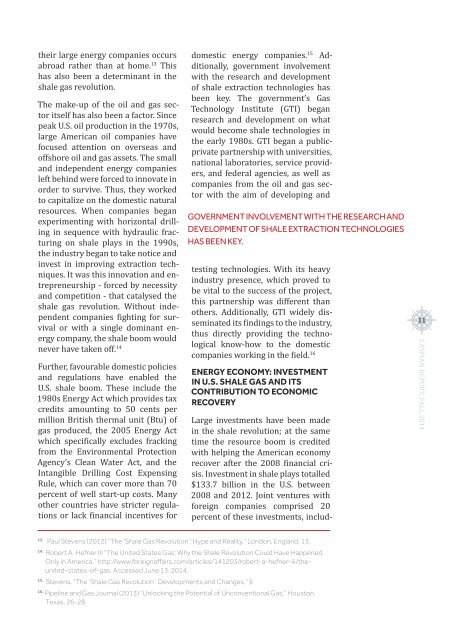You also want an ePaper? Increase the reach of your titles
YUMPU automatically turns print PDFs into web optimized ePapers that Google loves.
their large energy companies occurs<br />
abroad rather than at home. 13 This<br />
has also been a determinant in the<br />
shale gas revolution.<br />
The make-up of the oil and gas sector<br />
itself has also been a factor. Since<br />
peak U.S. oil production in the 1970s,<br />
large American oil companies have<br />
focused attention on overseas and<br />
offshore oil and gas assets. The small<br />
and independent energy companies<br />
left behind were forced to innovate in<br />
order to survive. Thus, they worked<br />
to capitalize on the domestic natural<br />
resources. When companies began<br />
experimenting with horizontal drilling<br />
in sequence with hydraulic fracturing<br />
on shale plays in the 1990s,<br />
the industry began to take notice and<br />
invest in improving extraction techniques.<br />
It was this innovation and entrepreneurship<br />
- forced by necessity<br />
and competition - that catalysed the<br />
shale gas revolution. Without independent<br />
companies fighting for survival<br />
or with a single dominant energy<br />
company, the shale boom would<br />
never have taken off. 14<br />
Further, favourable domestic policies<br />
and regulations have enabled the<br />
U.S. shale boom. These include the<br />
1980s Energy Act which provides tax<br />
credits amounting to 50 cents per<br />
million British thermal unit (Btu) of<br />
gas produced, the 2005 Energy Act<br />
which specifically excludes fracking<br />
from the Environmental Protection<br />
Agency’s Clean Water Act, and the<br />
Intangible Drilling Cost Expensing<br />
Rule, which can cover more than 70<br />
percent of well start-up costs. Many<br />
other countries have stricter regulations<br />
or lack financial incentives for<br />
domestic energy companies. 15 Additionally,<br />
government involvement<br />
with the research and development<br />
of shale extraction technologies has<br />
been key. The government’s Gas<br />
Technology Institute (GTI) began<br />
research and development on what<br />
would become shale technologies in<br />
the early 1980s. GTI began a publicprivate<br />
partnership with universities,<br />
national laboratories, service providers,<br />
and federal agencies, as well as<br />
companies from the oil and gas sector<br />
with the aim of developing and<br />
GOVERNMENT INVOLVEMENT WITH THE RESEARCH AND<br />
DEVELOPMENT OF SHALE EXTRACTION TECHNOLOGIES<br />
HAS BEEN KEY.<br />
testing technologies. With its heavy<br />
industry presence, which proved to<br />
be vital to the success of the project,<br />
this partnership was different than<br />
others. Additionally, GTI widely disseminated<br />
its findings to the industry,<br />
thus directly providing the technological<br />
know-how to the domestic<br />
companies working in the field. 16<br />
ENERGY ECONOMY: INVESTMENT<br />
IN U.S. SHALE GAS AND ITS<br />
CONTRIBUTION TO ECONOMIC<br />
RECOVERY<br />
Large investments have been made<br />
in the shale revolution; at the same<br />
time the resource boom is credited<br />
with helping the American economy<br />
recover after the 20<strong>08</strong> financial crisis.<br />
Investment in shale plays totalled<br />
$133.7 billion in the U.S. between<br />
20<strong>08</strong> and 2012. Joint ventures with<br />
foreign companies comprised 20<br />
percent of these investments, includ-<br />
11<br />
CASPIAN REPORT, FALL <strong>2014</strong><br />
13.<br />
Paul Stevens (2012) “The ‘Shale Gas Revolution’: Hype and Reality,” London, England, 13.<br />
14.<br />
Robert A. Hefner III “The United States Gas: Why the Shale Revolution Could Have Happened<br />
Only in America,” http://www.foreignaffairs.com/articles/141203/robert-a-hefner-iii/theunited-states-of-gas.<br />
Accessed June 13, <strong>2014</strong>.<br />
15.<br />
Stevens, “The ‘Shale Gas Revolution’: Developments and Changes,” 9.<br />
16.<br />
Pipeline and Gas Journal (2013) “Unlocking the Potential of Unconventional Gas,” Houston,<br />
Texas, 26-28.










